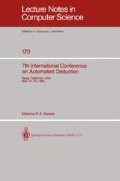Abstract
An automatic procedure was used to discover the fact that x 3 = x implies ring commutativity. The proof of this theorem was posed as a challenge problem by W.W. Bledsoe in a 1977 article. The only previous atttomated proof was by Robert Veroff using the Argonne National Laboratory — Northern Illinois University theorem-proving system. The technique used to prove this theorem was the Knuth-Bendix completion method with associative and/or commutative unification. This was applied to a set of reductions consisting of a complete set of reductions for free rings plus the reduction x × x × x → and resulted in the purely forward-reasoning derivation of x × y = y × x. An important extension to this methodology, which made solution of the x 3 = x ring problem feasible, is the use of cancellation laws to simplify derived reductions. Their use in the Knuth-Bendix method can substantially accelerate convergence of complete sets of reductions. A second application of the Knuth-Bendix method to the set of reductions for free rings plus the reduction x × x × x → x, but this time with the commutativity of multiplication assumed, resulted in the discovery of a complete set of reductions for free rings satisfying x 3 = x. This complete set of reductions can be used to decide the word problem for the x 3 = x ring.
This research was supported by the Defense Advanced Research Projects Agency under Contract N00039-80-0-0575 with the Naval Electronic Systems Command. The views and conclusions contained in this document are those of the author and should not be interpreted as representative of the official policies, either expressed or implied, of the Defense Advanced Research Projects Agency or the United States government. APPROVED FOR PUBLIC RELEASE. DISTRIBUTION UNLIMITED.
Access this chapter
Tax calculation will be finalised at checkout
Purchases are for personal use only
Preview
Unable to display preview. Download preview PDF.
References
Bledsoe, W.W. Non-resolution theorem proving. Artificial Intelligence 9,1 (August 1977), 135.
Comer, S.D. Elementary properties of structures of sections. Boletin de la Sociedad Matematica Mexicana 19 (1974), 78–85.
Huet, G. A complete proof of the correctness of the Knuth-Bendix completion algorithm. Journal of Computer and System Sciences 23,1 (August 1981), 11–21.
Huet, G. and J.M. Hullot. Proofs by induction in equational theories with constructors. Proceedings of the 21st IEEE Symposium on the Foundations of Computer Science, 1980.
Hullot, J.M. A catalogue of canonical term rewriting systems. Technical Report CSL-113, Computer Science Laboratory, SRI International, Menlo Park, California, April 1980.
Jacobson, N. Structure theory for algebraic algebras of bounded degree. Annals of Mathematics 46,4 (October 1945), 695–707.
Knuth, D.E. and P.B. Bendix. Simple word problems in universal algebras. In Leech, J. (ed.), Computational Problems in Abstract Algebras, Pergamon Press, 1970, pp. 263–297.
Lankford, D.S. Canonical algebraic simplification. Report ATP-25, Department of Mathematics, University of Texas, Austin, Texas, May 1975.
Lankford, D.S. Canonical inference. Report ATP-32, Department of Mathematics, University of Texas, Austin, Texas, December 1975.
Lankford, D.S. and A.M. Ballantyne. Decision procedures for simple equational theories with commutative axioms: complete sets of commutative reductions. Report ATP-35, Department of Mathematics, University of Texas, Austin, Texas, March 1977.
Lankford, D.S. and A.M. Ballantyne. Decision procedures for simple equational theories with permutativc axioms: complete sets of permutative reductions. Report ATP-37, Department of Mathematics, University of Texas, Austin, Texas, April 1977.
Lankford, D.S. and A.M. Ballantyne. Decision procedures for simple equational theories with commutative-associative axioms: complete sets of commutative-associative reductions. Report ATP-39, Department of Mathematics, University of Tcxes, Austin, Texas, August 1977.
Livesey, M. and J. Siekmann. Termination and decidability results for string-unification. Memo CSM-12, Essex University Computing Center, Colchester, Essex, England, August 1975.
Livesey, M. and J. Siekmann. Unification of A+C-terms (bags) and A+C+I-terms (sets). Interner Bericht Nr. 5/76, Institut für Informatik I, Universität Karlsruhe, Karlsruhe, West Germany, 1976.
Peterson, G.E. and M.E. Stickel. Complete sets of reductions for some equational theories. Journal of the Association for Computing Machinery 28,2 (April 1981), 233–264.
Peterson, G.E. and M.E. Stickel. Complete systems of reductions using associative and/or commutative unification. Technical Note 269, Artificial Intelligence Center, SRI International, Menlo Park, California, October 1982. To appear in M. Richter (ed.) Lecture Notes on Systems of Reductions.
Siekmanu, J. String-unification, part I. Essex University, Cochestcr, Essex, England, March 1975.
Siekmann, J. T-unification, part I. Unification of commutative terms. Interner Bericht Nr. 4/76, Institut für Informatik I, Universität Karlsruhe, Karlsruhe, West Germany, 1976.
Sticke], M.E. Mechanical theorem proving and artificial intelligence languages. Ph.D. Dissertation, Department of Computer Science, Carnegie Mellon University, Pittsburgh, Pennsylvania., December 1977.
Stickel, M.E. A unification algorithm for associative-commutative functions. Journal of the Association for Computing Machinery 28,3 (July 1981), 423–434.
Veroff, R.L. Canonicalization and demodulation. Report ANL-81-6, Argonne National Laboratory, Argonne, Illinois, February 1981.
Winkler, F. A criterion for eliminating unnecessary reductions in the Knuth-Bendix algorithm. CAMP-LINZ Technical Report 83-14.0, Ordinariat Mathematik III, Johannes Kepler Universität, Linz, Austria, May 1983.
Author information
Authors and Affiliations
Editor information
Editors and Affiliations
Rights and permissions
Copyright information
© 1984 Springer-Verlag Berlin Heidelberg
About this paper
Cite this paper
Stickel, M.E. (1984). A Case Study of Theorem Proving by the Knuth-Bendix Method: Discovering that x 3 = x Implies Ring Commutativity. In: Shostak, R.E. (eds) 7th International Conference on Automated Deduction. CADE 1984. Lecture Notes in Computer Science, vol 170. Springer, New York, NY. https://doi.org/10.1007/978-0-387-34768-4_15
Download citation
DOI: https://doi.org/10.1007/978-0-387-34768-4_15
Publisher Name: Springer, New York, NY
Print ISBN: 978-0-387-96022-7
Online ISBN: 978-0-387-34768-4
eBook Packages: Springer Book Archive

